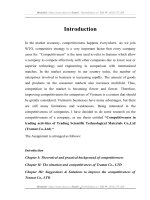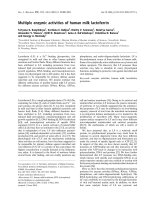Activities Of Mechandiser
Bạn đang xem bản rút gọn của tài liệu. Xem và tải ngay bản đầy đủ của tài liệu tại đây (2.28 MB, 36 trang )
Activities of Merchandiser
Activities of Merchandiser
Prepared by:
Md. Mozibur Rahman
ID: 112-323-007
Atish Dipankar University of Science and Technology
Departments of Textile Engineering
House-83, Road-4, Block-B, Banani, Dhaka-1213
Atish Dipankar University of Science and Technology
Departments of Textile Engineering
House-83, Road-4, Block-B, Banani, Dhaka-1213
What Is Apparel Merchandising?
Apparel Merchandising is all about costing of apparels, selecting and ordering latest
trendy materials, styles, sizes and overall apparel specifications to the
manufacturers according to the main buyer’s requirement. The people who
manage this whole apparel merchandising process is called apparel merchandiser
Responsibilities of a Merchandiser
•
Product Development
•
Market and product Analysis
•
Selling the concept
•
Booking orders
•
Confirming Deliveries
•
Designing and Sampling
•
Costing
•
Mediating production and quality departments
•
Giving shipping instructions and following shipping,
•
Helping documentation department
•
Taking responsibility for inspections and
•
Following up the shipment.
Objectives of Garments Merchandising
1.
To try to get garments order inquiry from buyer through various sources.
2.
To find out the consumptions of fabrics & accessories.
3.
To make costing on the garments inquiry.
4.
Procurement of raw materials.
5.
Follow up.
6.
Regular correspondence with buyer, suppliers and related personnel.
7.
Help and follow up in commercial activities.
8.
Arrange tests & inspections.
9.
To do shipment.
Apparel Merchandising Activity Cycle:
Work flow of Garments Merchandising
•
To collect buyers addresses.
•
To establish contact with the buyers sending formal letters/profile.
•
Receiving buyer’s response and providing price quotation along with making of sample as counter/approval.
•
Receiving samples comments from the buyer.
•
Receiving Purchase Order from buyer.
•
To furnish the pro-forma invoice and sending the buyer.
•
Receiving the master L/C & verify clauses of the L/C both in technical and commercial point of view.
•
To estimate time schedule for the exports of those garments as per L/C.
•
To confirm floor booking of the order with factory.
•
Taking necessary steps to develop lab-dips of the materials (FAB & ACC)
•
To confirm transfer authentication of the L/C in favor of fact.
•
Pushing the factory taking initial procurement to open the back-to-back L/C by bank.
•
Searching reliable fabric and accessories sources and finalize supplying of the required materials relevant to the order.
•
To monitor the shipment of raw materials and arrival in the factory.
•
To monitor of the supplying materials while receiving factory.
•
To order the test cutting with quality.
•
To check/inspect/advise for the bulk production.
•
To monitor production, quality and delivery.
•
To advise factory if buyer change any instruction both in technical/commercial point of view to the order.
•
To maintain continuous liaison with his or her controlling authorities.
•
Arrange inspections.
•
Sea vessel / air ship booking & insurance
•
Shipment
•
FOB(free on board) Order
•
FOA(Free on Air) Order
•
C& F(Cost & Freight) Order
•
CIF(Cost Insurance & Freight) Order
•
CIFC(Cost Insurance & Freight & Commission) Order
SAMPLE
The samples decide the ability of an exporter. The buyer will access the exporter and
his organization only by the samples. If the samples are of good quality and with
reasonable price naturally the buyers will be forced to place the order. So it is
essential that the samples should be innovative and with optimum quality. The
purpose of sampling is not only to get bulk orders and also give some additional
benefits to the exporters. By doing sampling the exporter can estimate the yarn
consumption for developing the fabric, a clear idea on costing more ever the
manufacturing difficulties.
Types of Sample
•
Salesmen samples or promotional samples
•
Photo samples
•
fit samples
•
Pre-production samples
•
Size-set sample
•
Production samples
•
Shipment samples
Consumption & Costing
Knit garments consumption:
Fabric Consumption:
Before calculate the fabric consumption, we must need the followings information as
mentioned below:
1) Measurement chart with technical spec.
2) Style Description.
3) Fabric Description.
4) Fabrics width/weight.
5) Washing shrinkage if any.
Calculation:
{(Body length + Sleeve length + Sewing Allowance) X (1/2 Chest
+ Sewing Allowance)}X 2 X GSM X 12 / 10000000 + Wastage (For 12 pcs of
garments)
Woven Garments Consumption:
Fabric Consumption:
Formula = Length X Width / Fabric width X Fabric Unit
Cost of Manufacturing (CM) Calculation:
COST OF MAKING (CM) ={(Monthly total expenditure of the following factory /
26) / (Qty of running Machine of your factory of the following month) X (Number of
machine to complete the layout)} / [{(Production capacity per hr from the existing
layout, excluding alter & reject) X 8}] X 12 / (Dollar conversion rate)
CBM calculation:
The cubic volume occupied by a shipment in Cubic Meters is referred to as the
shipments CBM. To calculate CBM we first need to know the length, width and
height of the carton in cm. If carton measurement is in inch, we have to convert
measurement in inch. Simply multiply length, width and height to find cubic
centimeter and divide by 1000000 to find cubic meter (CBM). formula as follows:
CBM= (LENGTH in cm X WIDTH in cm X HEIGHT IN cm/1000000)
BOOKING
Booking is the order sheet given from the manufacturer to the suppliers. After getting
the master LC from the buyer the manufacturer, Merchandisers are supposed to
make the booking and send the suppliers. By booking merchandisers procure the
raw materials e.g. fabric, accessories and trims.
Fabric booking:
Knit fabric booking is done mentioning the following criteria:
Composition: 100% cotton, 95% cotton 5% spandex etc
Construction: S/J, 1x1 rib etc
GSM: 140 gsm, 180 gsm etc
Quantity in Weight: e.g. 5000 kg
Color: Red, White, Blue etc
Composition: 100% cotton, 95% cotton 5% spandex etc
Construction: e.g. 40 X40 /120 X 60
Width: e.g. 44”, 46”
Quantity in length: e.g. 10000 yards
Color: Red, White, Blue etc
Merchandiser’s follow up tasks:
1. Product Package Analysis for Merchandising Follow up and Procurement
Planning.
2. Preparation of Time and Action Calendar for Merchandising Follow up.
3. Follow up of all BB L/C on receipt of Master L/C in respect of Yarn, Knitting,
Dyeing, Printing, Embroidery, Value-addition works and Accessories.
6. Follow up of Procurement of Yarn. Fabric and accessories.
8. Follow up of Lab-dip Preparation, Submission and Approval.
10. Follow up of Dyeing, Finishing.









